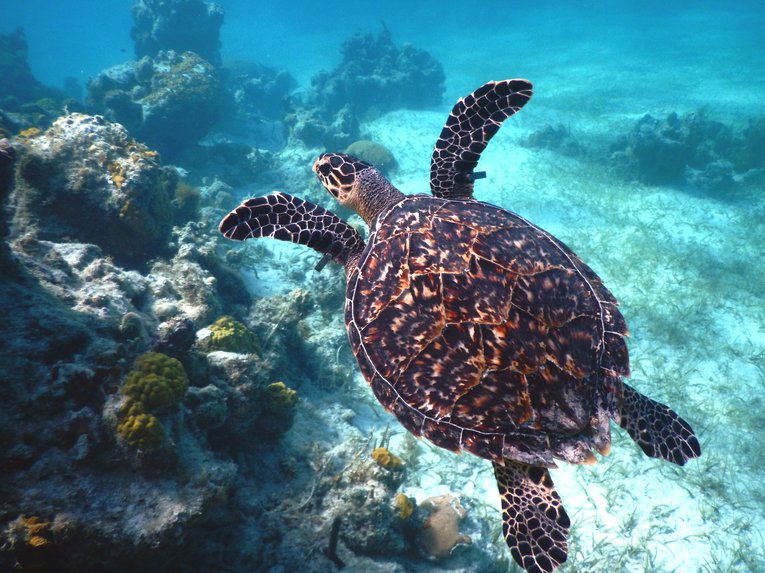
The seven species of marine turtles
Marine turtles have been around for millions of years, covering great distances in our ocean and playing a crucial role in marine and coastal ecosystems. There are seven different species of marine turtles, six of which have been recorded in UK waters.
Hard-shelled species of marine turtles are normally found in warmer seas and aren’t suited to the climate of UK waters. Those which are found in our waters are typically juveniles which have been carried off course.
Leatherback

A leatherback in UK waters
Credit: Colin Speedie
The leatherback, the largest marine turtle, is the species most frequently recorded in UK waters.
They can grow up to 2.91 metres in length and up to 916kg in weight. They have a flexible, leathery shell with pronounced ridges, which is black with white spots.
Leatherbacks are unique among reptiles in that they can metabolically raise their body temperature above that of their immediate environment, allowing them to survive in colder waters.
Each summer, leatherbacks migrate to UK waters where they feed on jellyfish.
Kemp’s ridley

A kemp's ridley turtle on the shore
Credit: Wildscreen Exchange / Ron Wooten
Kemp’s ridley turtles are the smallest sea turtle species in the world and are also the most endangered.
The Kemp's ridley has a triangular-shaped head with a slightly hooked beak. Its shell is often as wide, or wider, than it is long. Adults have an almost circular greyish-green top shell, with a yellow or cream bottom shell. Hatchlings are black on both sides.
Each of the front flippers has one claw while the back flippers may have one or two. Kemp’s ridleys grow up to 1 metre in length, but juveniles - which are around 30-50cm - have been found in UK waters.
Olive ridley

An olive ridley turtle swimming in the Pacific
Credit: Joost Van Uffelen via Shutterstock
The olive ridley turtle is a similar size to its sister species, Kemp’s ridley, growing up to 80cm and weighing less than 50 kg.
Despite being the most abundant, this sea turtle has only been recorded in UK waters once.
The olive ridley gets its name from its heart-shaped, olive-green coloured shell. Males and females grow to the same size, but females have a slightly more rounded shell. The olive ridley turtle has one or two claws on each flipper and a similar underside to Kemp’s ridley, but with five to nine pairs of costal scutes.
Green turtle

Green turtles over seagrass, Turks and Caicos Islands
Credit: Peter Richardson
The green turtle is found throughout the world, living in the coastal areas of more than 140 countries.
They grow up to 1.5 metres and have a rounded facial profile.
Green turtles are the only herbivore species of sea turtles, eating mostly seagrasses and algae. This diet is what gives their fat a greenish colour – which is where their name comes from.
Adult green turtles have dark olive or grey shells with dark blotches, and juveniles’ shells are chestnut coloured.
Loggerhead turtle

A loggerhead turtle in the ocean
Credit: Nat Taylor
Loggerhead turtles are named for their large heads and powerful jaws, which allow them to crush hard-shelled prey like clams and sea urchins.
They have a reddish-brown, heart-shaped shell, on which juveniles have small spikes along the spine. Other animals in its ecosystem are dependent on the loggerhead for survival, making it a ‘keystone species’. Their shells home over a hundred species of animals such as barnacles, crabs and algae.
Loggerheads grow up to 1.5 metres, but juveniles - which are 30cm-50cm - are also found in UK waters.
Hawksbill turtle

A hawksbill swimming over a reef in the Caribbean
Credit: Peter Richardson
Hawksbills are named for their narrow, pointed beaks which are perfect for finding food sources in hard-to-reach cracks and crevices. Their heads are tapered, and their lower jaw is V-shaped, giving them a hawk-like appearance.
Hawksbills have mottled shells with various shade of brown and amber and a black tortoiseshell pattern. Their shells also have overlapping scales which form a serrated-look on the edges.
Hawksbills are the only species of sea turtle that can survive on a diet consisting largely of sponges. They are mainly found in tropical waters and are rarely encountered in the UK’s seas.
The flatback turtle is the only species which hasn’t been recorded in UK waters to date. It has the smallest geographic range of all marine turtle species and is restricted to the coastal waters of Australia and Papua New Guinea.
Discover more about these wonderful animals by taking a look at our article answering all your marine turtle questions.




